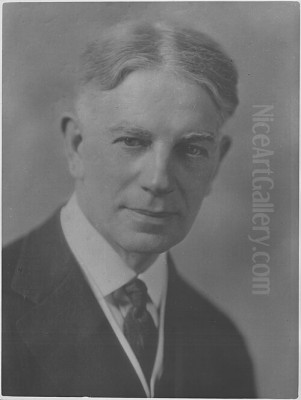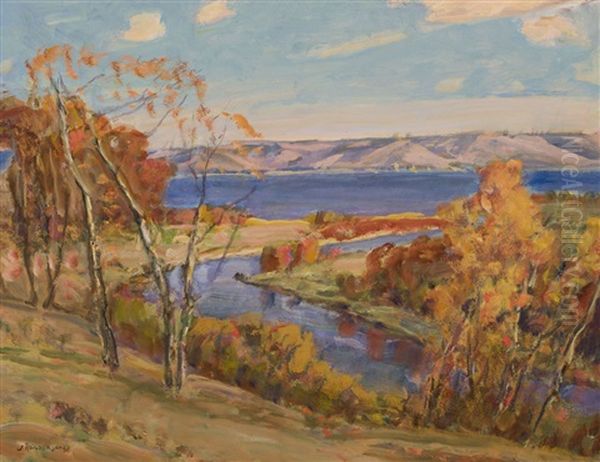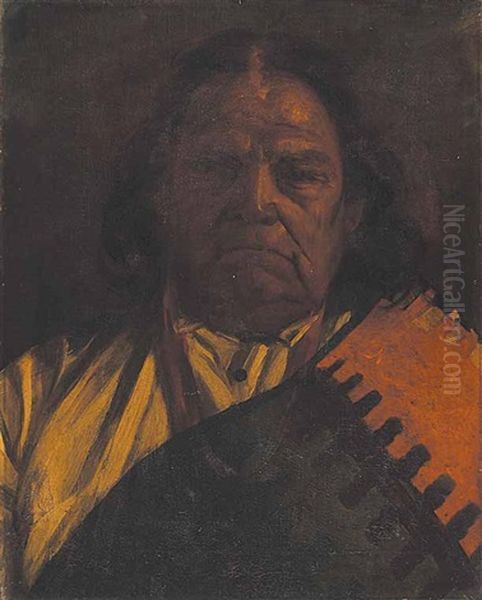
James Henderson (1871-1951) stands as a significant, if sometimes overlooked, figure in the annals of Canadian art. Born in Scotland and later immigrating to Canada, Henderson carved a unique niche for himself, primarily known for his evocative landscapes of the Canadian Prairies, particularly the Qu'Appelle Valley, and his sensitive, dignified portraits of Indigenous peoples. His work, deeply rooted in late Romantic and Impressionistic traditions, offers a poignant visual record of a specific time and place, reflecting both his European artistic heritage and his profound connection to his adopted Canadian homeland.
Early Life and Artistic Foundations in Scotland
Born in Glasgow, Scotland, in 1871, James Henderson's formative years were steeped in a rich artistic and industrial environment. Glasgow, at the time, was a burgeoning city, a hub of commerce and culture, and home to a vibrant art scene. It was here that Henderson began his artistic journey, undertaking an apprenticeship as a lithographer. This training, which sources suggest spanned from approximately 1887 to 1894, would have provided him with a strong foundation in draughtsmanship, composition, and the meticulous processes of printmaking.
During this period, Henderson also pursued formal art education, reportedly attending classes at the renowned Glasgow School of Art. This institution was a crucible of creativity, particularly associated with the "Glasgow Boys" – a group of artists including James Guthrie, John Lavery, and George Henry – who were challenging academic conventions and embracing more modern, often French-influenced, approaches like Impressionism and Realism. While Henderson may not have been a direct member of this group, their influence, along with that of other Scottish Impressionists, undoubtedly shaped his developing aesthetic, instilling in him an appreciation for capturing light, atmosphere, and the fleeting moments of nature.
Following his training in Glasgow, Henderson moved to London, the heart of the British art world. From roughly 1894 until 1909, he worked as a lithographer and engraver. This period in London would have exposed him to a wider array of artistic influences, from the established traditions of the Royal Academy to emerging modernist trends. His work in the commercial arts, while practical, also honed his technical skills, which would later serve him well in his fine art pursuits.
A New Beginning: Immigration to Canada

In 1910, James Henderson made a life-altering decision to immigrate to Canada. He settled in Regina, Saskatchewan, a relatively young city in the heart of the Canadian Prairies. This move marked a significant turning point in his career. Initially, he continued to utilize his commercial art skills to make a living, but his passion for painting soon took precedence. The vast, open landscapes of Saskatchewan and the distinct character of its light and seasons offered a new and inspiring subject matter, vastly different from the Scottish glens or the urban environment of London.
The Canadian Prairies, with their expansive skies and subtle beauty, began to feature prominently in Henderson's work. He became particularly enchanted with the Qu'Appelle Valley, a picturesque river valley that cuts through the prairie landscape. This region would become his most enduring muse, a place he returned to time and again to capture its unique atmosphere and changing moods. His background as a commercial artist and portrait painter in Regina provided a foundation, but his artistic spirit found its true expression in the landscapes and people of his new home.
Artistic Style: Romanticism and Impressionism on the Prairies
James Henderson's artistic style is most accurately described as a blend of Romanticism and Impressionism. His landscapes, often characterized as "romanticism of the natural landscape," evoke a sense of idyllic beauty and tranquility. There's a lyrical quality to his work, a gentle appreciation for the natural world that eschews grandiosity for a more intimate and personal connection. This approach was likely influenced by the British landscape tradition, which included masters like John Constable and J.M.W. Turner, who emphasized the emotional power of nature.
Henderson demonstrated a remarkable skill in rendering light and texture. His paintings often possess a soft, atmospheric quality, with carefully modulated tones and a keen sensitivity to the interplay of light and shadow. He employed a variety of mediums, including oil paints, watercolours, and charcoal, each chosen to best convey the specific qualities of his subject. His compositions are typically well-balanced, drawing the viewer into serene, sometimes subtly mysterious, scenes. While the bold, nationalistic style of the Group of Seven (including artists like Lawren Harris, A.Y. Jackson, and J.E.H. MacDonald) was gaining prominence in central Canada during Henderson's career, his work retained a more personal, European-inflected sensibility, focusing on the gentler, more pastoral aspects of the Canadian landscape.

His early training in Scotland, particularly the exposure to Scottish Impressionists, is evident in his brushwork and his attention to capturing the ephemeral effects of light. However, Henderson adapted these European techniques to the unique conditions of the Canadian Prairies, developing a style that was distinctly his own. His landscapes are not merely topographical records but are imbued with a sense of place and a quiet emotional resonance.
Chronicler of the Qu'Appelle Valley
The Qu'Appelle Valley in Saskatchewan held a special place in James Henderson's artistic vision. This scenic valley, with its winding river, wooded slopes, and historic First Nations communities, provided him with endless inspiration. He painted it in all seasons, capturing its diverse moods from the fresh greens of spring to the golden hues of autumn and the stark beauty of winter. His depictions of the valley are characterized by their peacefulness and their ability to convey the subtle grandeur of the prairie landscape.
These works stand as a significant contribution to the regional art of Saskatchewan and Western Canada. At a time when much of Canadian landscape art was focused on the rugged wilderness of the Canadian Shield or the majestic mountains of the West Coast, Henderson brought a sensitive eye to the often-underappreciated beauty of the prairies. His student, Marion Hamilton, also became known for her depictions of the Qu'Appelle Valley, suggesting Henderson's influence in fostering an appreciation for this local landscape among other artists.
Portraits of Dignity: Depicting Indigenous Peoples
Beyond his landscapes, James Henderson is perhaps most celebrated for his portraits of Indigenous peoples, particularly from the Cree and Saulteaux communities of the Qu'Appelle Valley and surrounding areas. These portraits are remarkable for their sensitivity, empathy, and the profound dignity with which they invest their subjects. Unlike some earlier depictions of Indigenous peoples by artists such as Paul Kane or Cornelius Krieghoff, which could sometimes tend towards the ethnographic or the romanticized "noble savage" trope, Henderson's portraits feel deeply personal and respectful.
He developed close relationships with many of his Indigenous sitters, and this mutual respect is evident in the final works. His portraits are not mere likenesses; they capture a sense of individual character, wisdom, and resilience. This aspect of his work earned him considerable recognition and a unique honor. The Standing Buffalo Dakota Nation, a First Nations reserve in the Fort Qu'Appelle area, bestowed upon him the honorary title of "Chief Wicowee Opa Wapitot," which translates to "The Man Who Paints Old Men" or "Artist Who Strives to Be Perfect." This honor speaks volumes about the esteem in which he was held by the Indigenous communities he portrayed.
These portraits are an invaluable cultural and historical record. They offer a glimpse into the lives and personalities of individuals from communities undergoing immense change and pressure during the early to mid-20th century. Henderson's ability to connect with his subjects on a human level allowed him to create images that transcend mere representation, becoming powerful testaments to the enduring spirit of Indigenous peoples. His approach can be seen as a more intimate counterpoint to the work of artists like Emily Carr, who, on the West Coast, was also deeply engaged with Indigenous cultures and art forms, albeit with a different stylistic and thematic focus.
Versatility in Mediums
James Henderson was a versatile artist, comfortable working in a range of mediums. His oil paintings, whether landscapes or portraits, often exhibit a rich texture and depth of color. He was also an accomplished watercolourist, using the medium's transparency and fluidity to capture the delicate nuances of light and atmosphere, particularly in his landscape sketches and studies.
Charcoal was another favored medium, especially for his portrait studies. The directness and expressive potential of charcoal allowed him to capture the essential features and character of his sitters with immediacy and strength. Furthermore, his early training as a lithographer remained a part of his artistic toolkit. While he became primarily known as a painter, his understanding of printmaking processes informed his compositional sense and his appreciation for line and tone. Some sources also mention his use of "Indian ink" and varnish, indicating an experimental and adaptive approach to his materials.
Exhibitions and Recognition
Throughout his career, James Henderson's work gained recognition, and he participated in various exhibitions. Notably, in 1936, his work was deemed worthy of inclusion in an exhibition at the prestigious Art Association of Montreal (now the Montreal Museum of Fine Arts). This acknowledgment from a major Canadian art institution indicates his growing reputation beyond Saskatchewan.
While detailed records of all his exhibitions are not readily available, his consistent production of high-quality work, particularly his landscapes of the Qu'Appelle Valley and his Indigenous portraits, ensured his place as one of Saskatchewan's most important early artists. The honor bestowed upon him by the Standing Buffalo Dakota Nation was perhaps one of his most cherished forms of recognition, signifying a deep cultural connection that went beyond formal art world accolades.
It is important to distinguish James Henderson (1871-1951), the Scottish-Canadian painter, from other notable individuals with similar names to avoid confusion. For instance, Nigel Henderson (1917-1985) was a prominent British photographer and artist associated with the Independent Group and the beginnings of Pop Art in Britain, known for his documentary-style photography of London's East End and his collage work. His artistic concerns and milieu were vastly different from those of James Henderson of Canada. Similarly, Hamish Henderson (1919-2002) was a highly influential Scottish poet, songwriter, and folklorist, a key figure in the Scottish folk revival, particularly associated with the Edinburgh People's Festival. The James Henderson discussed here focused his artistic endeavors on the visual representation of the Canadian West.
Contemporaries and Artistic Context
James Henderson worked during a dynamic period in Canadian art. The early 20th century saw the rise of the Group of Seven, who sought to define a distinctly Canadian artistic identity through their depictions of the northern wilderness. While Henderson shared their passion for the Canadian landscape, his approach differed. His style was less overtly nationalistic and more aligned with European Romantic and Impressionist traditions, applied to the specific environment of the Prairies.
In Western Canada, artists like Emily Carr were exploring the landscapes and Indigenous cultures of British Columbia with a powerful, modernist vision. Henderson's work in Saskatchewan offers a parallel, albeit stylistically different, engagement with regional identity and Indigenous representation. He was part of a generation of artists who were helping to build the cultural fabric of a rapidly developing nation, bringing their diverse backgrounds and artistic training to bear on the Canadian experience.
His contemporaries in Saskatchewan would have included other artists striving to capture the essence of the prairie region, though Henderson's focus on both landscape and Indigenous portraiture, combined with his particular stylistic blend, set him apart. His legacy is intertwined with the history of Saskatchewan art, and his paintings remain important touchstones for understanding the province's cultural heritage.
Legacy and Enduring Influence
James Henderson passed away in 1951, leaving behind a significant body of work that continues to resonate. His primary legacy lies in his sensitive and insightful portrayal of the Canadian Prairies, especially the Qu'Appelle Valley, and his dignified portraits of Indigenous peoples. He captured a unique aspect of the Canadian experience, offering a vision of the West that was both romantic and deeply felt.
His landscapes provide a valuable historical and artistic record of a region often overlooked in the broader narratives of Canadian art. They celebrate the subtle beauty and quiet grandeur of the prairies, inviting viewers to appreciate a landscape that might otherwise be perceived as monotonous. His paintings are held in various public and private collections, ensuring their continued accessibility.
Perhaps his most enduring contribution is his series of Indigenous portraits. In an era when Indigenous peoples often faced misrepresentation or neglect, Henderson's work stands out for its respect and humanity. These portraits are not just artistic achievements; they are important cultural documents that honor the individuals they depict and offer a window into their lives and traditions. The title "Chief Wicowee Opa Wapitot" serves as a lasting testament to the positive impact he had and the trust he built within these communities.
His work continues to be studied and appreciated for its artistic merit and its cultural significance. He demonstrated that an artist with European training could find profound inspiration in the Canadian landscape and its original inhabitants, creating a body of work that was both personal and universally resonant.
Conclusion: A Painter of Place and People
James Henderson (1871-1951) was an artist who bridged two worlds: his Scottish upbringing and artistic training, and his adopted home on the Canadian Prairies. He brought a romantic sensibility and an impressionistic touch to his depictions of the Qu'Appelle Valley, capturing its unique atmosphere with skill and affection. Even more significantly, his portraits of Indigenous peoples stand as powerful and dignified representations, born of mutual respect and understanding.
His representative works, such as "Untitled (Mountains in Banff)" and "Untitled (Mountain Scene in Banff)," though perhaps indicating travels beyond his primary Saskatchewan focus, showcase his skill in capturing the grandeur of landscape, a skill he so adeptly applied to the gentler terrains of the prairies. Through his dedication to his craft and his chosen subjects, James Henderson made a lasting contribution to Canadian art, leaving behind a legacy that celebrates the beauty of the land and the dignity of its people. He remains a key figure in the art history of Saskatchewan and a testament to the power of art to connect across cultures and landscapes.